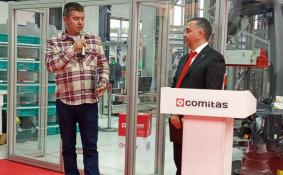Scientific & Practical Journal

Editorial News
Dear readers! We are pleased to present to you the eleventh issue of the journal in 2025. There are a lot of relevant and useful materials in the issue, which, hopefully, will not be ignored.
Dear readers! In September the CeMAT RUSSIA exhibition was held, which showed everyone that innovations and robotics are increasingly penetrating the logistics industry. We can safely say that many technologies are tested here, and only then they go out into the world. However, it is not only CeMAT RUSSIA that demonstrates the prevalence of the digital agenda.
Dear readers! This is the ninth issue of the journal, which turned out to be very rich and diverse. Traditionally, the issue is opened by an analyst. The material by Alina Nasyrova from the Market Guide Agency, dedicated to investments in warehouse complexes in Russia, recalls the importance of developing logistics infrastructure for the integrated development of regions.
PHOTO OF THE WEEK
CITATIONS
All News of Logistics
PTV Group offers a virtual world to test future automotive developments with PTV Vissim
Intertraffic Amsterdam, 07.04.2016. Connected and Autonomous Vehicles (CAVs) are already present on the roads of many countries around the globe. Established functions such as adaptive cruise control, emergency braking and lane assistance are already in existence with the development, testing and funding of further autonomous vehicle technology well underway.
Industry, governments and research are pushing the use of CAVs in real traffic to their full potential where benefits include, removing driver error to increase safety, smoothing vehicle flow to reduce emissions and reducing congestion across our road networks. This is where the use of traffic modelling and simulation can assist decision makers by quantifying the impact of increasing levels of CAVs, helping to identify what effect this will have on future transport infrastructure.
PTV customers from across the government, consultancy, academia and automotive sectors use PTV Vissim to help answer questions related to CAVs on our road networks. The leading software for microscopic traffic simulation has been used to test future CAV technology within a virtual environment, allowing the behaviour of CAV’s across a wide range of scenarios to be simulated and analysed in detail. Testing can be carried out for different road conditions with multiple simulations giving the potential for long distances to be tested and analysed overnight.
One exciting project commissioned by the UK Department for Transport looks to simu-late the potential impacts CAVs may have on traffic flow and capacity of the UK road network. Atkins, as the engineering consultancy, was selected to complete the project using PTV Vissim.
Atkins project manager Dr. Dave Williams gave his insights to the project: “There are lots of uncertainties around the future of connected and autonomous vehicles. Whilst we are starting to understand what the capabilities might be, our aim for this project is to contemplate a range of different possible futures for CAVs. For example, whilst it is often assumed that CAVs will be able to travel at shorter headways, we are considering scenarios where CAVs are more cautious than the existing vehicle fleet, and looking at the implications for road capacity.
Our testing in PTV Vissim 8 involves modifying the car-following and lane-changing models to look at a range of different behaviours. Through the COM API we have con-figured CAVs to change their behaviour type according to the situation – this is an important aspect of evaluating the potential impacts of connectivity.”
The project is due to report in mid 2016. Find out more on virtual testing for future automotive developments in PTV Vissim at the PTV stand 11.401 at Intertraffic Amsterdam.












